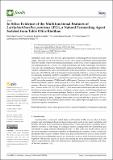Por favor, use este identificador para citar o enlazar a este item:
http://hdl.handle.net/10261/305346COMPARTIR / EXPORTAR:
 SHARE SHARE
 CORE
BASE CORE
BASE
|
|
| Visualizar otros formatos: MARC | Dublin Core | RDF | ORE | MODS | METS | DIDL | DATACITE | |

| Título: | In Silico Evidence of the Multifunctional Features of Lactiplantibacillus pentosus LPG1, a Natural Fermenting Agent Isolated from Table Olive Biofilms |
Autor: | López-García, Elio CSIC ORCID ; Benítez-Cabello, Antonio CSIC ORCID ; Ramiro-García, Javier CSIC ORCID; Ladero Losada, Víctor Manuel CSIC ORCID ; Arroyo López, Francisco Noé CSIC ORCID | Palabras clave: | Fermented vegetables Genome overview Probiotic Starter culture Whole-genome sequencing |
Fecha de publicación: | 22-feb-2023 | Editor: | Multidisciplinary Digital Publishing Institute | Citación: | Foods 12 (5): 938 (2023) | Resumen: | In recent years, there has been a growing interest in obtaining probiotic bacteria from plant origins. This is the case of Lactiplantibacillus pentosus LPG1, a lactic acid bacterial strain isolated from table olive biofilms with proven multifunctional features. In this work, we have sequenced and closed the complete genome of L. pentosus LPG1 using both Illumina and PacBio technologies. Our intention is to carry out a comprehensive bioinformatics analysis and whole-genome annotation for a further complete evaluation of the safety and functionality of this microorganism. The chromosomic genome had a size of 3,619,252 bp, with a GC (Guanine-Citosine) content of 46.34%. L. pentosus LPG1 also had two plasmids, designated as pl1LPG1 and pl2LPG1, with lengths of 72,578 and 8713 bp (base pair), respectively. Genome annotation revealed that the sequenced genome consisted of 3345 coding genes and 89 non-coding sequences (73 tRNA and 16 rRNA genes). Taxonomy was confirmed by Average Nucleotide Identity analysis, which grouped L. pentosus LPG1 with other sequenced L. pentosus genomes. Moreover, the pan-genome analysis showed that L. pentosus LPG1 was closely related to the L. pentosus strains IG8, IG9, IG11, and IG12, all of which were isolated from table olive biofilms. Resistome analysis reported the absence of antibiotic resistance genes, whilst PathogenFinder tool classified the strain as a non-human pathogen. Finally, in silico analysis of L. pentosus LPG1 showed that many of its previously reported technological and probiotic phenotypes corresponded with the presence of functional genes. In light of these results, we can conclude that L. pentosus LPG1 is a safe microorganism and a potential human probiotic with a plant origin and application as a starter culture for vegetable fermentations. | Descripción: | 19 Páginas.-- 6 Figuras.-- 1Tabla.-- Material suplementario | Versión del editor: | http://dx.doi.org/10.3390/foods12050938 | URI: | http://hdl.handle.net/10261/305346 | DOI: | 10.3390/foods12050938 | E-ISSN: | 2304-8158 |
| Aparece en las colecciones: | (IG) Artículos (IPLA) Artículos |
Ficheros en este ítem:
| Fichero | Descripción | Tamaño | Formato | |
|---|---|---|---|---|
| foods_2023_V12_938.pdf | Artículo principal | 3,07 MB | Adobe PDF |  Visualizar/Abrir |
| foods_2023_V12_938_MatSuppl.xlsx | Material suplementario | 3,01 MB | Microsoft Excel XML | Visualizar/Abrir |
CORE Recommender
PubMed Central
Citations
5
checked on 30-abr-2024
SCOPUSTM
Citations
5
checked on 15-may-2024
WEB OF SCIENCETM
Citations
4
checked on 26-feb-2024
Page view(s)
35
checked on 17-may-2024
Download(s)
67
checked on 17-may-2024

